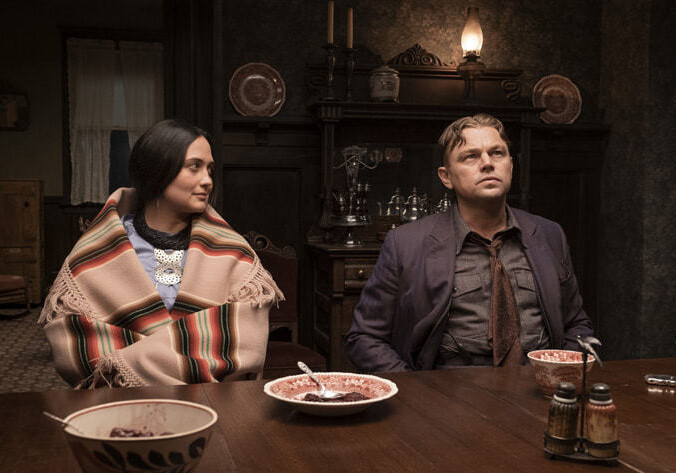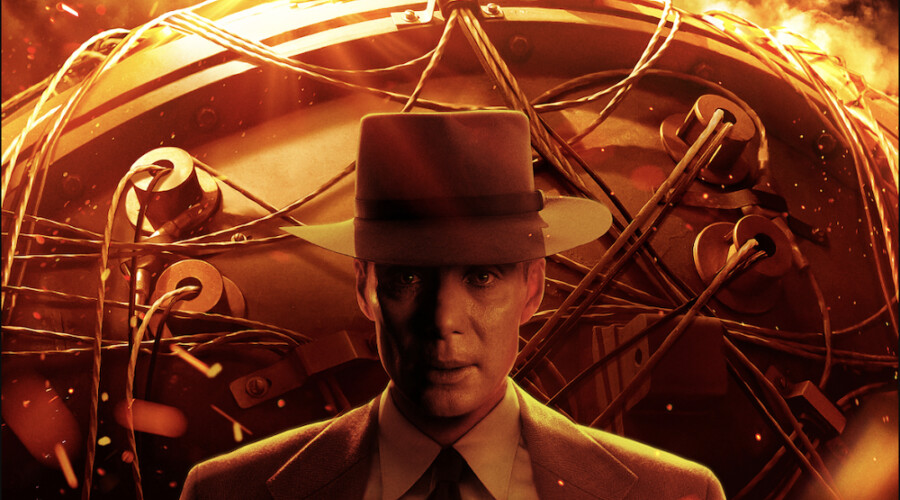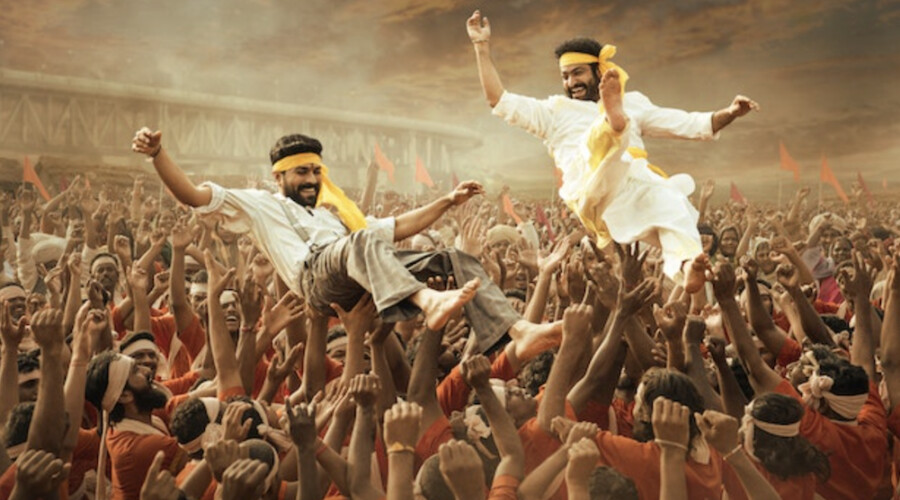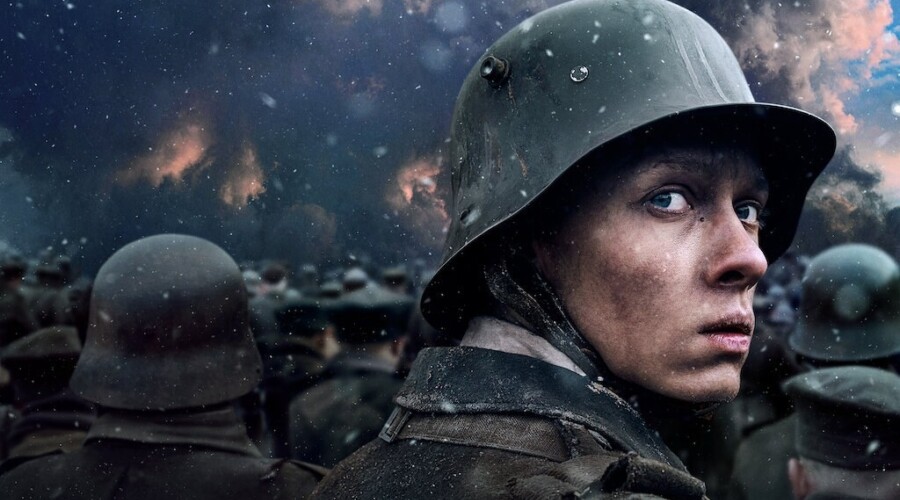Martin Scorsese’s films, especially those focused on mobsters, have certain hallmarks: they’re overly long, but still watchable; there are lots of side characters that you wished you knew more about; and the gangsters, whatever awful things they may do, have a certain amount of charm. But it’s perhaps overlooked that these films do have a strong moral center. The “bad guys” may spend most of the film carousing, making jokes, and drinking and eating like kings, but by the end, they’re usually victims of sadistic murderers, dying alone in prison, or isolated from the life they knew; they reap what they sowed.
Much of this is also on display in Killers of the Flower Moon. Clocking in at just under three-and-half-hours, everything is in place for a Scorsese classic, with a huge and talented cast, and a rich and complex story about morally bankrupt gangsters who do eventually get some form of comeuppance. But something is quite different. This is not a mafia tale about a gang war or degenerate gamblers; the subject matter is instead pure greed and the genocide of the Native Americans. There’s barely any of the dark humor of Goodfellas or The Departed. The mobsters rarely look like they’re having fun, the violence gets progressively more heart-wrenching, and the justice meted out feels woefully insufficient for the crimes that were committed. Scorsese knew he had to tell this story delicately, but just how delicately he told it, and whether it was even his story to tell, is up for debate.
Synopsis
This film, based on a non-fiction book of the same name by David Gann, begins in the early 1920s in dusty Oklahoma where, after enduring centuries of genocide, disease, wars, displacement, and outright thievery, it seems as if the Osage Nation finally has found a bit of luck. Though they were pushed out of their native Missouri to a reservation in Oklahoma, the tribe is sitting on an enormous oil reserve. Tribe members are thus able to cash in on their “headrights” and many of them become quite wealthy. This, in turn, leads to a rush of white settlers, who also want a piece of the money. And as the film shows it, maybe the best way to get access to this money, was to marry into the Osage Nation.
Among these settlers is a cattle rancher named William King Hale (Robert DeNiro), who professes to love and care for the Osage, learns their language, and is basically an honorary member of their community. His nephew Ernest Burkhart, recently returned from the front lines of World War I, is also enamored of him and soon follows his advice, marrying a wealthy Osage woman named Mollie Kyle (Lily Gladstone), setting him up for a share of the oil money.
Though Ernest and Mollie seem to be in love, all is far from well. Members of the Osage Nation keep turning up murdered, while others die young from mysterious health problems. Mollie, who is diabetic herself (and also eventually being poisoned), rarely leaves her bed for a large part of the film and is at the center of this suffering. One sister is shot in the head, another dies of “wasting disease,” yet another is blown up in her own house while she slept, and their mother stays sick in bed for years before dying. At a certain point (which is hard to pinpoint exactly) it becomes totally clear that Hale is responsible for most, if not all, of this death, with his nephew as an accomplice—however wittingly is up for debate. Eventually a vestigial version of the FBI shows up in the form of Agent Thomas Bruce White, Sr. (Jesse Plemons). Many of the murderers are put on trial and eventually sent to jail, but the Osage Nation can never recover—the death toll from this Reign of Terror is at least 60, but could be in the hundreds.
Whose Story to Tell?
The best part of Flower Moon was Gladstone’s performance. Much has been written about her "knowing" smile, her composure in the face of pure horror, and her intelligence that is evident in the way she carries herself. In one of her first conversations with Ernest, she asks if he’s scared of his uncle; it’s a stunning moment, as she soon marries Ernest, despite seemingly knowing that there is some kind of darkness to come. Unfortunately, we don’t get enough of these moments, as the story is not told from her perspective. Aside from a few scenes with her family, we learn about Mollie through Ernest. Scorsese’s story begins when Ernest arrives in Oklahoma, so we know little about her before she was married. As the film goes on, Mollie's life becomes dominated by what her husband and his uncle are doing to her and her family. We learn even less about her sisters and mother and the dozens of other members of her community who were murdered.
Instead, Ernest is at the center of the story. We don’t really know much about him either—he likes whiskey too much, is not that bright, and calls his uncle King—but, through his actions, his story is much easier to piece together. It’s the story of the greedy ignorant American, who sees himself unquestionably at the top of the food chain and the wide-open prairie as his for the taking. Ernest, though thoroughly misguided, didn’t go to Oklahoma to be a murderer. Indeed, at first, it’s a bit unclear how much he knows of the plot to kill as many Osage Nation members as possible. Eventually, though—maybe even to his surprise—he’s fully invested in the conspiracy. Despite his seemingly genuine love for Mollie, he still goes along with the plot to poison her (“just slow her down,” as his uncle says) and helps to set up at least two murders.
As the film was told from the perspective of the “oppressors,” Nelson Mandela’s famous quote comes to mind: “The oppressor must be liberated just as surely as the oppressed. A man who takes away another man’s freedom is a prisoner of hatred, he is locked behind the bars of prejudice and narrow-mindedness . . . The oppressed and the oppressor alike are robbed of their humanity.” Of course, the conspirators benefited monetarily, but what kind of life were they leading if they had to lie, steal, and murder to get their money? This weighed heavily on Ernest, so much so that at one point he mixes his whiskey with the same poison that he put in Mollie’s insulin. Hale, though, seems barely affected and, monstrously and pathetically, is unable to stop scheming even as he’s behind bars. It is surely a valid critique that we don’t know more about the victims, but Scorsese vividly illustrated the lack of humanity of these oppressors. In stark contrast to his other gangster films, there is no glory to be found in Osage County.
The Feds to the Rescue?
By the time Agent White shows up to investigate the murders (about two hours into the film), you’re so ensconced in this horrific outlaw world, that you forget that someone like Hale can be held accountable for his actions. But he and Ernest and several other conspirators are all soon arrested for the murders. Many of them get deals to testify and Hale is outed as the mastermind. With courtroom cameos from John Lithgow and Brendan Fraser, Scorsese gives these scenes a climactic feel, even though it’s clear that there will never really be justice for Mollie and the Osage Nation.
So much of what happened to this community was, ultimately, the fault of the same federal government that finally decided to investigate the murders. It was the government that was responsible for moving them to Oklahoma in the first place, and of course it did the same and much worse to millions of other Native Americans over the course of the previous 150 years. The government was also responsible for the legal machinations that led to these headrights being so easily transferred from the Osage, which was the reason that most of the white men moved to the region in the first place.
A saga like this has to be simplified so that it can be a film, but at what point do you lose the essence of the story? There is a sense, from watching Flower Moon, that this story began when Hale cajoled Ernest into the conspiracy and ended when they went to prison. Of course, the story began hundreds of years earlier and the Reign of Terror in Osage Nation was just one heartbreaking episode in the genocide of the Indigenous population of North and South America, with the reverberations still being felt in the 2020s.
Starting the Conversation?
Despite the blessing from and deep consultation with the Osage Nation, there are some members of the Native American community who feel that this film should not have been made. Though she makes sure to praise Gladstone and the other Native actors in the film, Reservation Dogs star Devery Jacobs, a member of the Mohawk community, wrote on X: “Indig ppl exist beyond our grief, trauma & atrocities. Our pride for being Native, our languages, cultures, joy & love are way more interesting & humanizing than showing the horrors white men inflicted on us . . . I would prefer to see a $200 million movie from an Osage filmmaker telling this history, any day of the week.”
Nancy Marie Mithlo, a Chiricahua Apache writer, called the film a “disaster.” She goes on to speak about Native suffering on display in the film: “It's unique from other marginalized communities because when you prompt for empathy, basically what gets triggered is this objectification, because Native people are objects, just like mascots, just like our artifacts . . . They objectify them more readily, and it has everything to do with the cowboys and Indians trope. And this film just extends that trope further.”
As a white man, writing this review in Queens, New York, on land stolen from the Canarsie, Marsapeague, Matinecock, and Rockaway people, I cannot argue with these sentiments. I am grateful that I know more about the Reign of Terror in Osage County in the 1920s and its certainly important that we have more discussions about the genocide of the Native Americans and how that shapes our society. But, perhaps, a Martin Scorsese film isn’t the right way to tell these stories. Using the “grief, trauma, & atrocities” experienced by Indigenous people as entertainment, however challenging Flower Moon was to watch, is hard to defend.
Discussion Questions
1. Should Martin Scorsese have made Killers of the Flower Moon? Should a Native American director have made the film?
2. Was this story too complex for a Hollywood movie? Should it have been a documentary, a longer series, or just stayed as a book?
3. Was Scorsese fair in telling the stories of the victims of the Reign of Terror? How do you feel about how he treated the characters of William King Hale and Ernest Burkhart?
4. What do you think about the film's portrayal of the federal government? Did Scorsese simplify its role in the Reign of Terror?
5. Are there any other episodes in U.S. history that you think should be made into a film?
Works Cited
"All Eyes on Lily Gladstone," New York, Alison Wilmore, December 5, 2023
"The Dark Message of Killers of the Flower Moon," The Nation, Jorge Cotte, November 27, 2023
"Dramatic and Moral Ambitions Clash in 'Killers of the Flower Moon'," The New Yorker, Anthony Lane, October 9, 2023
Long Walk to Freedom, Nelson Mandela, Little Brown & Co., 1994
"Opinion: Scorsese’s ‘Killers of the Flower Moon’ does a disservice to its source material," CNN, Noah Berlatsky, October 23, 2023
"Osage Nation members react to 'Killers of the Flower Moon'," Today, Kristian Burt and Liz Calvario, October 20, 2023
"Pressing pause on 'Killers Of The Flower Moon' and rethinking Scorsese's latest," NPR, It's Been a Minute, November 14, 2023
"Thoughts on 'Killers of the Flower Moon,' Ethical Storytelling, and Writing Characters Unlike Yourself," Script, Valerie Kalfirin, October 26, 2023
"What Indigenous Artists Are Saying About Killers of the Flower Moon," New York, Jason P. Frank, October 25, 2023
Carnegie Council for Ethics in International Affairs is an independent and nonpartisan nonprofit. The views expressed within this article are those of the author and do not necessarily reflect the position of Carnegie Council.




